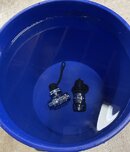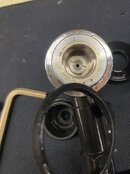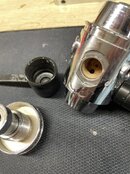iointerrupt
Contributor
Do rubber DIN dust caps leak when rinsing regulators with them? Should they be banished to the landfill, replaced with the one true dust cap, the screw-on cap? Are there more important things I should be working on?
These are the questions that have been plaguing me for the last months. I have seen many (ok, a few) claims, that rubber DIN dust caps, as supplied by regulator manufacturers, are unsuitable for anything but keeping dust out of a first stage regulator. That when left submerged, water will leak past the cap and into the regulator body. And so only by using screw-on caps, which seal against the DIN o-ring, can you safely dunk.
Given these ideas, I set out to find out for the truth. The experimental setup I decided upon is as follows: A 5 gallon bucket with 12" (30cm) of water, two "volunteer" regulators with their factory rubber dust caps on, and then 30 days of waiting:

After a month of staring at the bucket, waiting, not working on more important things, here are the results:
First up, the ScubaPro Mk2:

First we note that there is water in the dust cap! However, the back half of the cap is dry. As for the regulator itself? Not a single drop inside.
Next up, the Poseidon 2960:

Here again, the same result. Water gets into the dust cap around the threads, but not a drop makes it past the DIN o-ring into the regulator body.
So there you have it. Make sure your dust caps are fully seated against the DIN o-ring, and you'll be good to soak for at least 30 days.
Actually, probably want to soak them for less than that, as these regulators came out with a nice layer of slime algae growing on all the rubber parts...
These are the questions that have been plaguing me for the last months. I have seen many (ok, a few) claims, that rubber DIN dust caps, as supplied by regulator manufacturers, are unsuitable for anything but keeping dust out of a first stage regulator. That when left submerged, water will leak past the cap and into the regulator body. And so only by using screw-on caps, which seal against the DIN o-ring, can you safely dunk.
Given these ideas, I set out to find out for the truth. The experimental setup I decided upon is as follows: A 5 gallon bucket with 12" (30cm) of water, two "volunteer" regulators with their factory rubber dust caps on, and then 30 days of waiting:

After a month of staring at the bucket, waiting, not working on more important things, here are the results:
First up, the ScubaPro Mk2:

First we note that there is water in the dust cap! However, the back half of the cap is dry. As for the regulator itself? Not a single drop inside.
Next up, the Poseidon 2960:

Here again, the same result. Water gets into the dust cap around the threads, but not a drop makes it past the DIN o-ring into the regulator body.
So there you have it. Make sure your dust caps are fully seated against the DIN o-ring, and you'll be good to soak for at least 30 days.
Actually, probably want to soak them for less than that, as these regulators came out with a nice layer of slime algae growing on all the rubber parts...



